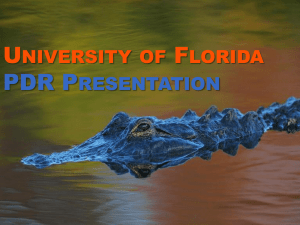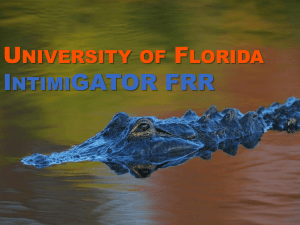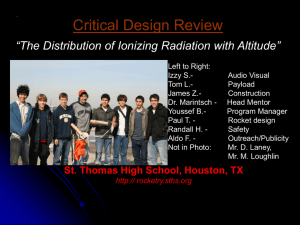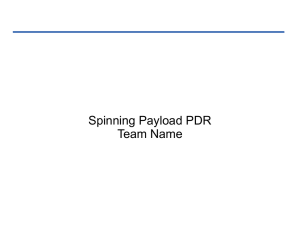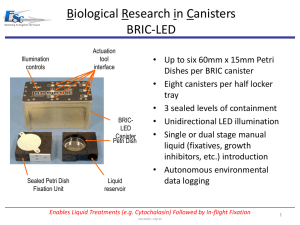- University of New Hampshire
advertisement
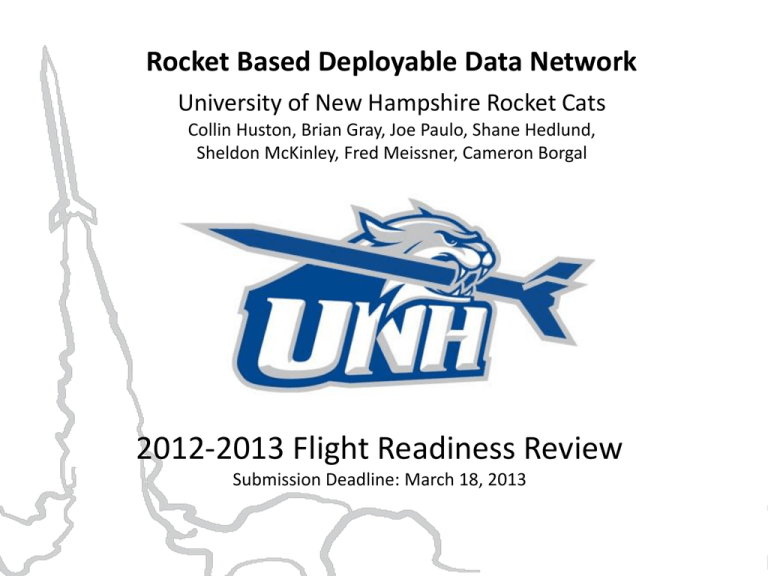
Rocket Based Deployable Data Network University of New Hampshire Rocket Cats Collin Huston, Brian Gray, Joe Paulo, Shane Hedlund, Sheldon McKinley, Fred Meissner, Cameron Borgal 2012-2013 Flight Readiness Review Submission Deadline: March 18, 2013 Overview • • • • • • • • • • • • • • • • • • Objective Launch Vehicle Design and Dimensions Key Design Features Motor Selection Mass Statement and Mass Margin Stability Margin Recovery Systems Kinetic Energy Predicted Drift Test Plans and Procedures Full-scale Flight Test Recovery Testing Summary of Requirements Verification Payload Design Key Design of the Payload Payload Integration Interfaces Summary of Requirements Verification Objective • The UNH Rocket Cats aim to create a Rocket Based Deployable Data Network (RBDDN). The objective is to design a low cost data network that can be deployed rapidly over a large area utilizing rockets. Launch Vehicle Dimensions Vehicle Dimensions • 75.2” in length • 4” Outer Diameter • 10” Span Diameter Key Design Features • 2+1 event recovery system to allow safe vehicle recovery with separate payload ejection • Piston based ejection system for the main parachute • Removable aluminum bulkheads to allow for full tube access • Fiberglass and Kevlar reinforced blue tube Motor Selection • Cesaroni Technology Inc. K740-CS Reloadable Motor • Total Length: 15.9 in (4 grain) • Diameter: 54 mm • Launch Mass: 51.8 oz. • Total Impulse: 1855 Ns • Average Thrust:747 N • Maximum Thrust: 869 N • Burn Time: 2.48 seconds • Thrust to weight ratio: 9:1 • Exit Rail Velocity : 45.17 ft/s Mass Statement Component: Mass: Notes: Motor Casing 12.15 Weighed with retention ring Fin Can 52.75 Includes retention ring Secondary Payload 20.3 With electronics and threaded rod Removable Bulkhead 6.6 With eyebolt Drogue 5.5 With Harness and Nomex Avionics Bay Tube 4.3 With epoxied t-nuts Avionics 16.1 With avionics, batteries, nuts, threaded rod Drogue Bulkhead 4.85 Main Bulkhead 5.35 Piston 6.5 Main Harness 5.85 Parachute Bay 10.95 Main Parachute 10.7 With Quicklink Main Payload 29.2 With electronics and threaded rod Payload Recovery 14.4 With battery and fixing bolt Nosecone 15.25 Empty Payload Parachute 4.25 With Nomex, Harness and Quicklink Motor (J740) 51.84 Mass (loaded) Ballast 19.2 Added to removable bulkhead Total 296.04 With Nomex blanked Stability Margin • Static Stability Margin – 1.81 calibers • Center of Pressure – 53.5” from the nose tip • Center of Gravity – 46.3” from the nose tip Recovery Systems (Parachute Selection) Section Parachute Choice Area [𝒇𝒕𝟐 ] Drogue Public Missile Works PAR-30 4.91 Payload Public Missile Works PAR-24 Main Sky Angle 44 𝑪𝒅 𝒇𝒕 Velocity [ 𝒔 ] Kinetic Energy [ft*lbf] .75 54.80 600.34 3.14 .8 35.64 65.5 21.1 1.87 14.2 29.7 Recovery Systems (Altimeter Selection) Altimeter Selection Primary Deployment Altitude Secondary Deployment Altitude Primary PICO-AA2 Apogee 700’ Backup ADEPT DDC22 Apogee 700’ Payload PICO-AA1 Apogee+50s None (700’ from vehicle) Kinetic Energy • KE = 1 𝑚𝑣 2 2 • The kinetic energy values shown are calculated from the chosen parachutes for the rocket Section Parachute Choice Velocity (ft/s) Kinetic Energy (ft*lbf) Drogue Public Missile Works PAR-30 54.8 600.34 Payload Public Missile Works PAR-24 35.64 65.5 Main Sky Angle 44 14.2 29.7 Predicted Drift Vehicle Wind Speed [mph] Estimated Drift [ft] 0 8 5 440 10 850 15 1300 20 1800 Deployed Payload Wind Speed [mph] Estimated Drift [ft] 0 8 5 440 10 1041 15 1862 20 2483 Vehicle Testing and Procedures Function Testing Procedure Charge Testing The recovery systems were ground tested by prepping the rocket and ejecting the parachutes and primary payload. Fin Testing Fin flutter was tested theoretically with fin flutter velocity theory and then compared to physical testing in a wind tunnel. Parachute Testing Parachute testing was conducted by dropping the primary payload and vehicle off of a tall structure with the parachutes open to study the velocity at impact. Altimeter testing Altimeter testing was conducted within a pressured chamber and also by creating an impulse on the accelerometer. Tests of the Staged Recovery System • Deployed the main and drogue parachutes. • Deployed the nose cone. • Successfully tested the main parachutes ejection charge potential of deploying the nose cone in the event of a nose cone deployment failure Ejection charge testing set up. Successful deployment of main parachute and nose cone by main parachute charge. Full-scale Flight Test #1 • Successful exit from rails • Successful main payload deployment • Issues with vehicle recovery systems caused total parachute failure or “lawn dart” • Failure causes determined and improved through post flight inspection Full-scale Flight Test #2 • Mission success for all vehicle requirements • Payload flown with mass simulators • Drift well controlled in high winds Summary of Requirements Verification (Vehicle) • Cesaroni K740: – Apogee of 5,282 feet (AGL) • Altimeters: – PICO-AA2 (primary), ADEPT DDC22 (primary backup), and PICOAA1(nose cone) • Vehicle velocity: – 0.58 Mach • Recoverable & Reusable: – Non-degradable and reusable materials were used. • Independent Sections: – 3 sections, nose cone, booster section, and parachute bay. • Prepared for flight within 2 hours: – Full scale test launch took 1 hour and 36 minutes to fully prepare. Summary of Requirements Verification (Continued) • Remain in launch ready state for 1 hour: – Estimates suggest 8 hours of functionality before any functionality is lost. • Rail size: – The rocket is functional with a 10 10 rail size. • 12 volt direct current firing system: – Succesfully launched full scale with a 12 volt current firing system. • No external circuitry – There is no external circuitry. • Commercially available motor: – Cessaroni K740 • Total impulse less than 5,120 Ns: – 1855 Ns Summary of Requirements Verification (Continued) • Ballast: – The ballast is less than 10% of the unballasted vehicle mass. • Successful full scale launch: – Successful launch was completed on March 17, 2013 Payload Design Overview • Primary payload – Deployed payload in nose cone – Atmospheric and GPS sensor data – Transmit and store sensor data • Secondary payload – GPS sensor data – Act as node in network, transmit, and receive relevant data Primary payload exploded diagram Primary payload in nose cone Payload Sled Design • Fiberglass trays with aluminum threaded rods and Delrin® blocks • Machined aluminum rear bulkhead and fiberglass front bulkhead • Primary sled dimensions: 11.5” x 3.75” • Secondary sled dimensions: 7” x 3.9” Primary Payload Components • Arduino Nano – Barometer: BMP085 – Humidity and Temperature: SHT15, Cantherm MF51-E thermistor – Ambient Light: PDV-P9200 – Ultraviolet: PC10-2-TO5 • Raspberry Pi • GlobalSat BU-353 GPS • Xbee 900 Pro Secondary Payload Components • Raspberry Pi • GlobalSat BU-353 GPS • Xbee 900 Pro Secondary payload model render Payload Testing and Procedures Function Testing Procedure Battery Life testing Allow the system for extended lengths of time under battery power. Xbee range testing Ground station yagi antenna and smaller payload antennas are coupled to the Xbee transmitters and tested for transmission distance. Software testing Packets of data are sent between the payloads and ground station to verify transmission integrity and packet handing. Sensor testing and calibration Atmospheric sensors tested on the prototype circuit board for continuity and are calibrated against known conditions for accuracy. Strength Testing/Integrity Drop testing and launches to verify system hardware integrity. Payload Integration • Sled containing primary payload is secured in nosecone using external bolts • Sled containing secondary payload is secured in rocket body using the same method. Interfaces • Primary payload connects to recovery system via direct wired connection • Communication to ground station and deployed nodes via Xbee 900mHz connection • Avionics are isolated in separate bay • Testing for effects of EMI performed • 1” Launch rails Conclusion The team has built and tested a rocket for competition in the NASA-USLI. We are excited to travel to Huntsville and show off our hard work. Questions?


